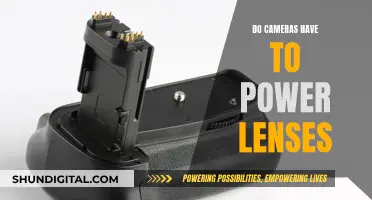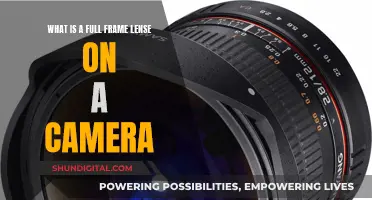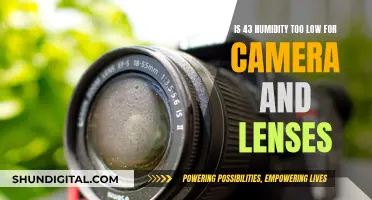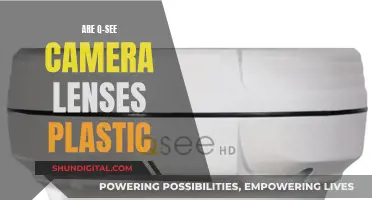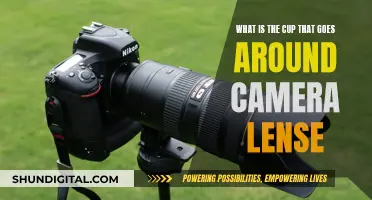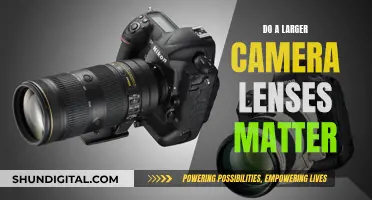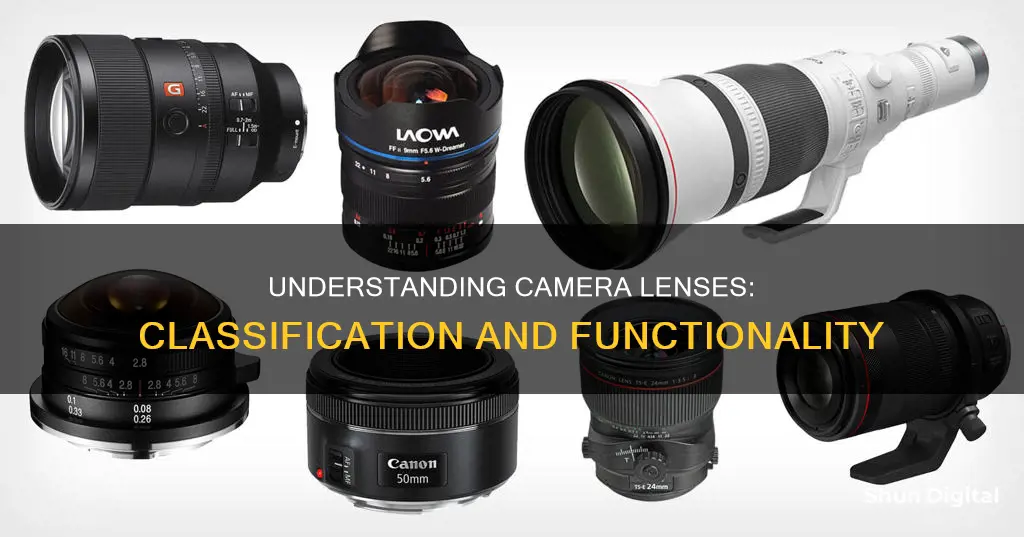
Camera lenses are essential for focusing light to form an image on the camera's digital sensor or film plane. They are classified by their specific focal length in millimetres, which determines the magnification of the image and the angle of view. The two broad categories of lenses are prime and zoom. Prime lenses have a fixed focal length, while zoom lenses have a variable focal length that allows you to change your composition by zooming in and out. Prime lenses tend to be sharper, smaller, lighter, and cheaper, while zoom lenses offer more flexibility.
| Characteristics | Values |
|---|---|
| Type | Prime or Zoom |
| Focal Length | 6mm-800mm+ |
| Angle of View | 50° (normal) or wider (wide-angle) or narrower (telephoto) |
| Aperture | f/1.4-f/22 |
| Focus | Autofocus or manual |
| Image Stabilisation | Optical or digital |
| Mount | Bayonet, screw-thread, or friction-lock |

Prime vs Zoom Lenses
Overview
Camera lenses are classified into two types: zoom lenses and prime lenses. Zoom lenses offer a variable focal length, allowing photographers to adjust the angle of view by turning the zoom ring. On the other hand, prime lenses have a fixed focal length, requiring photographers to physically move closer or farther from the subject to change the composition of the shot.
Advantages of Prime Lenses
- Cost: Prime lenses are often significantly cheaper than zoom lenses, making them a budget-friendly option for photographers.
- Size and Weight: Prime lenses tend to be more compact, lightweight, and easier to carry than zoom lenses, especially when comparing lenses of the same class and focal length.
- Image Quality: Prime lenses generally produce sharper images and offer larger maximum apertures, resulting in better low-light performance and more pleasing bokeh effects.
- Creative Control: The larger apertures of prime lenses provide greater creative control over depth of field, allowing for beautifully blurred backgrounds.
- Learning Composition: Prime lenses force photographers to "zoom with their feet," encouraging them to move around and explore different angles, thus improving their composition skills.
Advantages of Zoom Lenses
- Versatility: Zoom lenses offer a range of focal lengths in a single lens, providing the convenience of capturing both wide and close-up shots without the need to change lenses.
- Image Stabilization: Many modern zoom lenses feature advanced image stabilization systems, allowing photographers to capture sharp images even in low-light conditions or when shooting non-moving subjects.
- Weight Reduction: Carrying a single zoom lens that covers a wide focal range can reduce the overall weight of your gear, making it easier to travel and move around.
- Ease of Use: Zoom lenses offer compositional flexibility, especially in constrained spaces where physical movement is limited. Turning the zoom ring is often more convenient than having to move closer or farther from the subject.
The choice between a prime and a zoom lens depends on your specific needs and preferences. Prime lenses offer superior image quality, larger apertures, and compact size, while zoom lenses provide the convenience of multiple focal lengths in one lens. Consider your budget, shooting style, desired level of versatility, and the types of photography you plan to do to make an informed decision.
Understanding APS-C Camera and Lens Cropping: What's the Difference?
You may want to see also

Standard Lenses
The standard 50mm lens is commonly referred to as a 'normal' lens. For 35mm film or sensors, the diagonal of a 24x36mm area is 43.3mm, so lenses with focal lengths between 40mm to 55mm are considered 'normal'. 50mm became the standard normal lens for 35mm after that focal length was favoured and selected by Oskar Barnack, the creator of the Leica camera and a father of 35mm photography.
The versatility of standard lenses makes them great 'walk-around lenses' and a good fit for many types of photography, such as portraits, landscapes, and travel. They are also often used for street photography and portraits, as well as sports, wildlife, and action photography.
CCD Camera Lenses: Color Corrected or Not?
You may want to see also

Macro Lenses
The most popular macro lenses have a focal length of between 90mm and 105mm. They are a manageable size and weight, affordable, and have a convenient minimum focus distance of around 30cm. The distance between the front of the lens and the subject is typically around 14cm, which is ideal for close-up shooting.
Most macro lenses have a widest aperture of f/2.8, except for long focal length lenses, which have a widest aperture of f/3.5. Aperture affects convenience when focusing manually, as shooting at the widest aperture will result in a shallow depth of field.
When choosing a macro lens, it's important to consider the focal length and minimum focusing distance. Lenses with longer focal lengths have longer minimum focusing distances, which can be useful when shooting bugs and other small wildlife, or inanimate objects, as it prevents the lens from casting a shadow over the subject.
How Does an Eclipse Affect Camera Lenses?
You may want to see also

Telephoto Lenses
Camera lenses can be divided into two types: zoom lenses and prime lenses. Zoom lenses are incredibly versatile and are a common choice for wedding photographers. Telephoto lenses are a type of zoom lens with a focal length that ranges from 100mm to 600mm or more. They are often used for sports, wildlife, and nature photography, as they allow photographers to capture subjects from a distance.
When choosing a telephoto lens, it is important to consider its versatility, range, stabilisation, size, and weight. While a superzoom telephoto lens offers a wide range of focal lengths, it may result in decision fatigue and struggle to shoot anything due to having too many options. Additionally, in landscape photography, going past the 250mm mark can cause a loss of perspective and key compositional elements, as well as atmospheric challenges like haze and a "mirage" effect.
Overall, telephoto lenses are a specialised type of camera lens that can be extremely useful for specific types of photography, such as sports and wildlife, where the distance between the photographer and the subject is significant.
Squaretrade Coverage for Camera Lenses: What You Need to Know
You may want to see also

Wide-Angle Lenses
There are two main varieties of wide-angle lenses: short-focus lenses and retrofocus lenses. Short-focus lenses are composed of multiple glass elements with symmetrical shapes in front of and behind the diaphragm. As the focal length decreases, the distance between the rear element of the lens and the film plane or digital sensor also reduces. Short-focus wide-angle lenses are not ideal for single-lens reflex cameras unless their reflex mirrors are locked up. On the other hand, they are widely used in large-format view cameras and rangefinder cameras because they produce less distortion than retrofocus lenses, and there is no need for a long back focal distance.
Retrofocus lenses, on the other hand, feature an asymmetrical design that positions the rear element farther away from the film plane than its focal length would suggest. This design solves the proximity issue that short-focus lenses face. An example of this is an 18mm retrofocus lens, where the rear element is typically more than 25mm from the film plane.
The first wide-angle lens was developed in the 1850s by photographer Thomas Sutton. It utilised a water-filled lens to create panoramic visuals without the need for a rotating body.
Sigma Lenses: Blackmagic Cinema Camera Compatibility Guide
You may want to see also
Frequently asked questions
Prime and zoom. Prime lenses have a fixed focal length, while zoom lenses have a variable focal length.
A standard lens has a mid-range focal length, typically around 50mm. They produce images that appear "natural" to the viewer as their angle of view is similar to the angle that the human eye can comfortably view.
A macro lens is designed for close-up photography, allowing you to photograph subjects at very short distances. They have excellent sharpness and contrast, resulting in eye-catching photos.
A telephoto lens has a long focal length and provides a high level of magnification, allowing you to photograph subjects at a moderate to far distance. They are commonly used in wildlife, sports, and portrait photography.
A wide-angle lens has a short focal length and provides an angle of view beyond that of a standard lens, capturing more of the scene in a single shot. Extreme wide-angle lenses are known as fisheye lenses and can capture up to 180 degrees.


